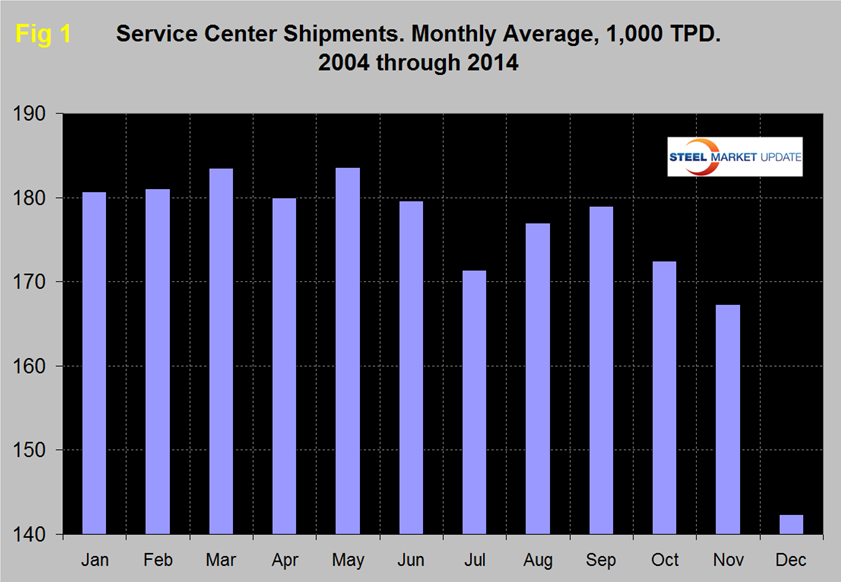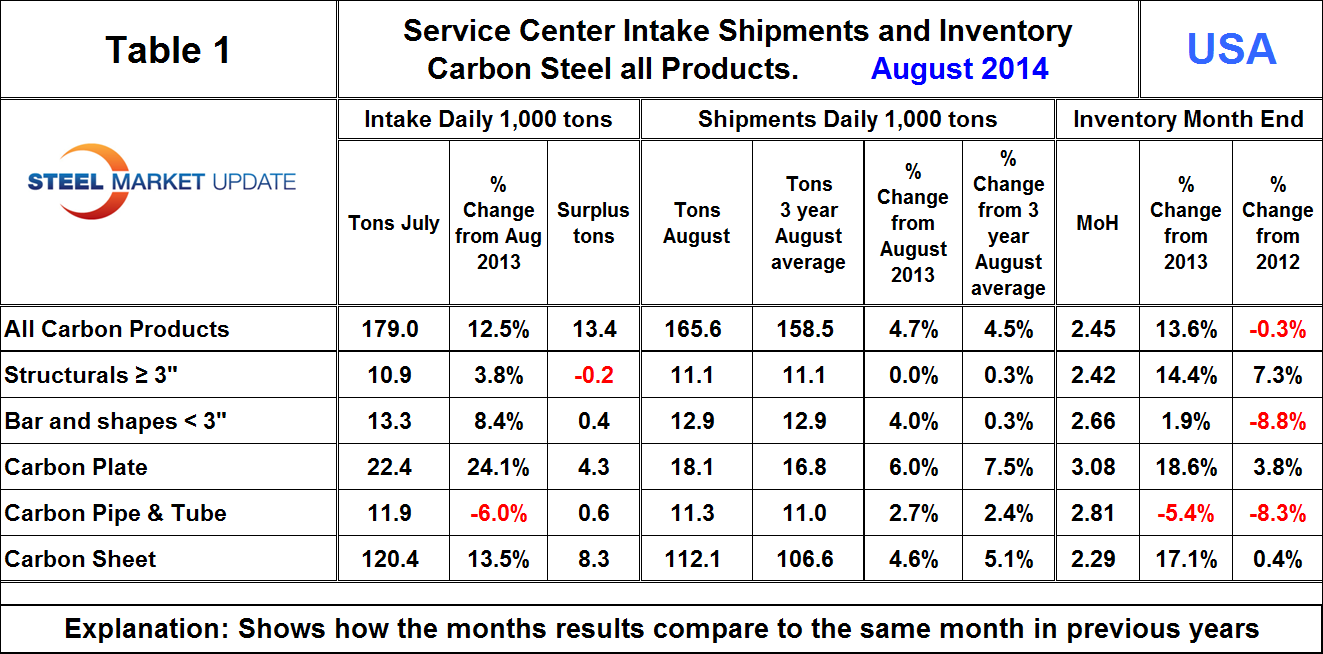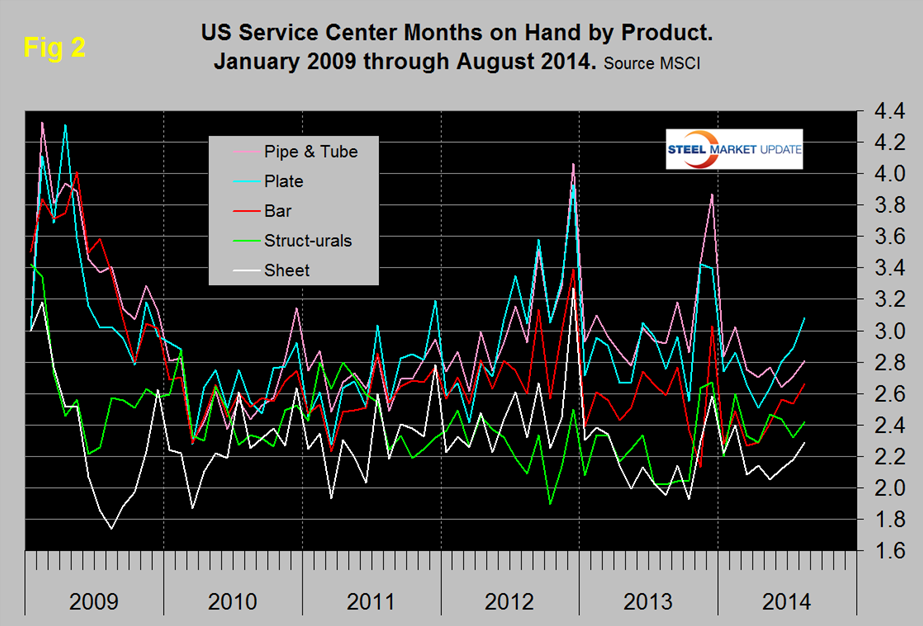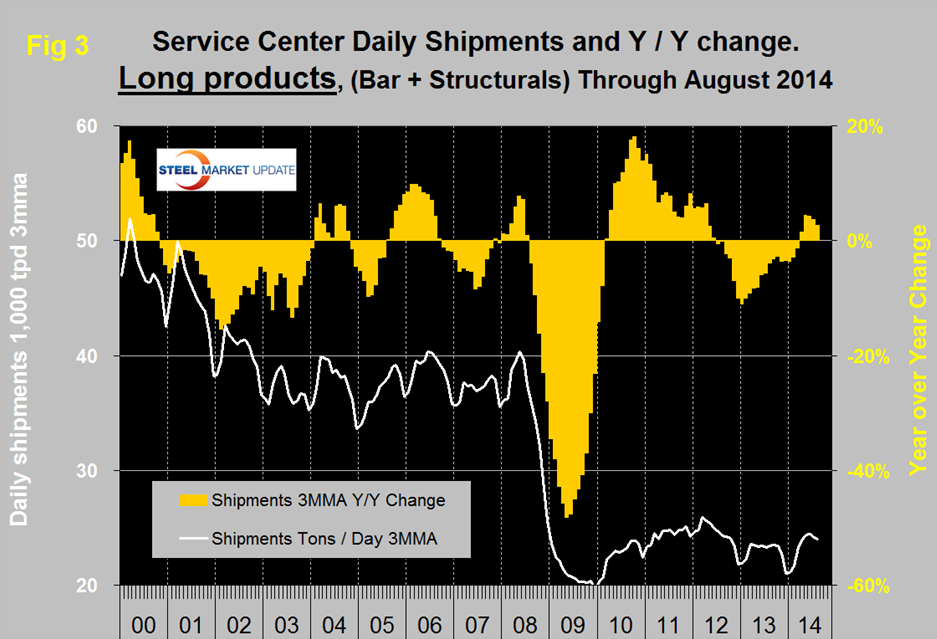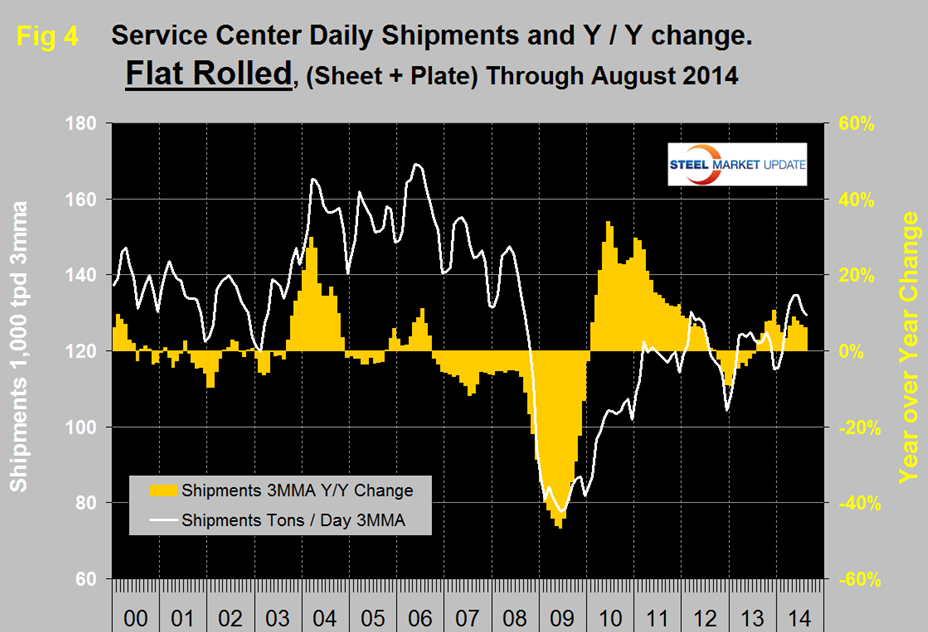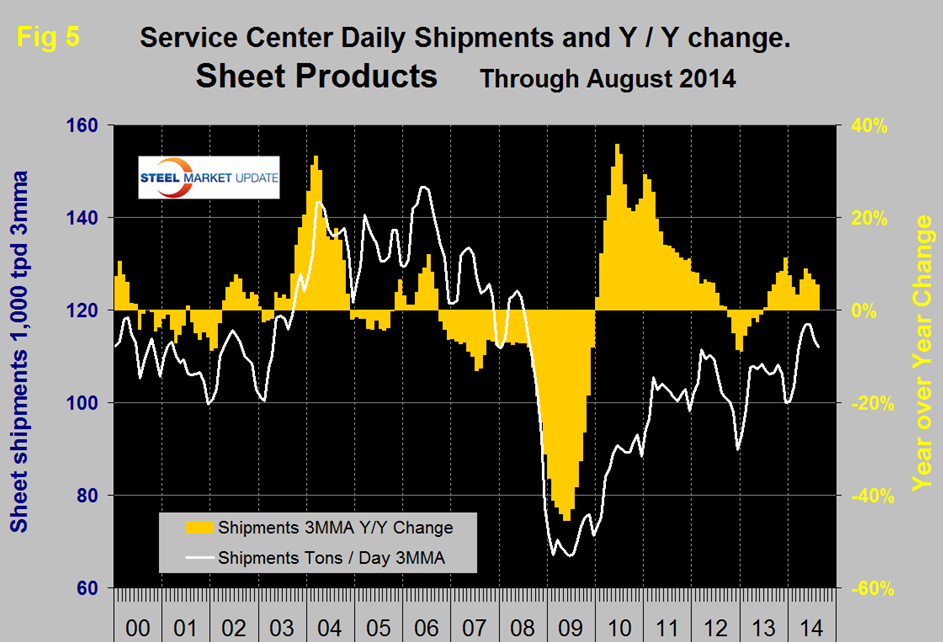Steel Mills

Service Center Intake, Shipments and Inventory in August 2014
Written by Peter Wright
September 19, 2014
Total service center carbon steel shipments in August decreased by 61,400 tons to 3.477 million tons. Shipping days also decreased from 22 to 21. On a tons per day basis (t/d) shipments increased from 160,900 tons in July to 165,600 in August. All three months June, July and August had the best t/d shipments of that month since 2008. Daily shipments in August increased by 2.9 percent from July, the average increase July to August since 2004 has been 3.3 percent. Figure 1 demonstrates the seasonality of service center shipments and why comparing a month’s performance with the previous month is usually misleading. For this reason in the SMU analysis we always consider year over year changes.
Table 1 shows the performance by product in August compared to the same month last year and also with the average t/d for August 2014, August 2013 and August 2012. We then calculate the percent change between August 2014 August 2013 and with the 3 year August average. We hope this give the best view of market direction. Shipments of all products on a t/d basis were up by 4.7 percent from August last year and up by 4.5 percent from the average August shipments for 2014, 2013 and 2012. The fact that the single month comparison has a greater improvement than the three year comparison leads us to the conclusion that the improvement is accelerating. This is particularly true of carbon bar which includes rounds, flats and shapes <3” maximum dimension. (As an aside it should be noted that both the MSCI and AISI definition of bar sized shapes is different from the international definition which is <80mm. This means that the specific size 3” which is a high tonnage item for angles and channels is considered a structural shape by MSCI and AISI but is a bar sized shape by international definition including all import data.) Returning to Table 1, all products except structurals had positive shipment growth on both time comparisons. The t/d shipments of structurals were unchanged from August 2013. Sheet products were up by 4.6 percent year over year and by 5.1 percent in the three year comparison.
August total carbon steel intake increased by 9,490 t/d, the highest daily volume since January 2012 and led to a surplus of 13,400 tons t/d. All products except structurals had an intake surplus in August. Months on hand (MoH) increased from 2.33 at the end of July to 2.45 at the end of August.
Compared to the end of August last year, moth end inventories were up by 13.6 percent in total, with flat rolled leading the way. Plate was up 18.6 percent and sheet up 17.1 percent. Figure 2 shows the MoH by product since January 2009. Plate and bar inventories have increased markedly in the last four months, sheet was also up significantly in the last three. Sheet products constitute by far the largest segment of service center’s business, have had the best inventory management since 2009 and currently have the lowest months on hand at 2.29.
There continues to be a wide difference between the performances of flat rolled (sheet + plate) and long products (structurals + bar) at the service center level. Long products have had a very poor recovery from the recession. On a 3MMA basis y/y, the growth of shipments was negative for 21 straight months until April this year which was the first of five straight months of growth, (Figure 3).
Flat rolled has had a much better recovery since mid-2009 and has had positive y/y growth in each of the last thirteen months, (Figure 4). In 2006 and 2007, the mills and service centers were operating at maximum capacity. Figure 5 takes the shipments by product since that time frame and indexes them to the average for 2006 and 2007 in order to measure the extent to which service center shipments of each product have recovered. Again it can be seen that bar and structurals have the worst record. Sheet has had the best recovery since the beginning of 2013 but plate caught up in August. Even so the recovery of sheet is only at 85.6 percent and plate at 86.2 percent. The total of carbon steel products is now at 78.0 percent of the shipping rate that existed in 2006 and 2007, ranging from plate at 86.2 percent to structurals at 62.5 percent. The recovery of the service center sector has been much slower than has been experienced by the mills. Presumably this is because more buyers are purchasing mill direct and this is probably particularly true of long products. In addition long products being more construction oriented are suffering from the slow recovery of that business sector.
MSCI uses product nomenclature flat and plate. In our analysis at SMU we replace the term flat with sheet. By our interpretation of the MSCI’s data their definition of “flat” is all hot rolled, cold rolled and coated sheet products. Since most of our readers are sheet oriented we have removed plate from Figure4 to highlight the history of sheet products which are shown in (Figure 5). Positive year over year growth has occurred in each of the last fourteen months following nine consecutive months of decline.
The SMU data base contains many more product specific charts than can be shown in this brief review. For each product we have ten year charts for shipments, intake, inventory tonnage and months on hand. Readers are welcome to these on request but please don’t ask for all of them at once!

Peter Wright
Read more from Peter WrightLatest in Steel Mills

Nucor names Batterbee, Bledsoe to HR roles
Nucor Corp. has promoted Thomas J. Batterbee to the position EVP of human resources and talent and appointed Elizabeth Bledsoe to the newly created position of president of human resources and talent.

Millett sees tariffs, CORE case benefiting SDI
Steel Dynamics' top exec thinks Trump’s tariff policies, as well as the results from the recent CORE case, will prove advantageous to the Fort Wayne, Ind.-based steelmaker and aluminum company.

USW digs in on opposition to USS-Nippon deal
“We remain deeply concerned about the national and economic security implications of the subject transaction,” the union stated in the letter dated April 21.

SDI’s Q1 earnings slump on-year, but up sequentially
SDI earnings slip in first quarter year over year, but are up sequentially.

POSCO inks MoU with Hyundai on Louisiana EAF mill
POSCO has signed a Memorandum of Understanding (MoU) with Hyundai Motor Group that includes an equity investment in Hyundai’s previously announced EAF mill set to be built in Louisiana.

